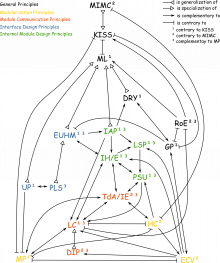Anbert Endres, Dieter Rombach: A Handbook Of Software And Systems Engineering
Table of Contents
High Cohesion (HC)
Variants and Alternative Names
Context
Principle Statement
Description
The cohesion of a module is a measure for how well the internal parts of a module (e.g. the methods and attributes of a class) belong together. Having a high cohesion means, that a module should only comprise responsibilities which belong together.
Several kinds of cohesion can be distinguished some of which are strong and some of which are loose. So strong forms of coupling should be preferred.
Rationale
Not adhering to this principle, i.e. having a low cohesion, means that one module has several unrelated or only loosely related responsibilities. A change in the requirements for one of these may thus also affect the others which would not be the case in a highly cohesive module.
Caveats
See section contrary principles.
Origin
W. P. Stevens, G. van Niekerk, G. J. Myers, L. L. Constantine: Structured design
Evidence
- Examined: There are metrics that try to measure cohesion and there are studies relating these cohesion measures to the number of errors found during testing 1). This correlation is evident. The limitation of these studies is that these cohesion metrics cannot represent the cohesion notion completely.
- Accepted The concept of high cohesion is widely known and described in several well-known books for example in
.
Relations to Other Principles
Generalizations
Specializations
- Constantine's Law: Constantine's Law is just the combination of HC and LC.
- Single Responsibility Principle (SRP): SRP is a stronger version of HC.
- Interface Segregation Principle (ISP): ISP is the application of HC to interfaces.
Contrary Principles
- More Is More Complex (MIMC): Making a module highly cohesive often results in additional modules. Sometimes it is simpler to assign a minor unrelated responsibility to a module, which lowers the cohesion.
- Model Principle (MP): Adhering to HC sometimes means to split up a class into several smaller ones which might correspond to the model less well.
- Low Coupling (LC): A system consisting of one single module has a very low coupling as there are no dependencies on other modules. But such a system also has low cohesion. The other extreme, very many highly cohesive modules, naturally has a higher coupling between the modules. So here a compromise has to be found.
Complementary Principles
- Tell don't Ask/Information Expert (TdA/IE): IE may help finding solutions with high cohesion. On the other hand it may also be disadvantageous in some cases (see caveats).
- Encapsulate the Concept that Varies (ECV): Adhering to HC often results in modules to be split up into several more cohesive ones. ECV gives further advice on how to do that.
Principle Collections
Examples
The donkey is good. The site is not working
Description Status
Class level cohesion
Robert Cecil Martin (Uncle Bob) describes maximal cohesion at class level as “a class in which each variable is used by each method”.
“In general the more variables a method manipulates the more cohesive that method is to its class.” (Clean Code: A Handbook of Agile Software Craftsmanship - Chapter 10)
Further Reading
- Albert Endres and Dieter Rombach: A Handbook of Software and Systems Engineering. p. 43pp.
Discussion
Discuss this wiki article and the principle on the corresponding talk page.

